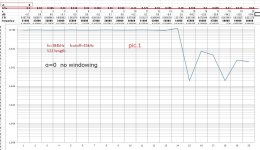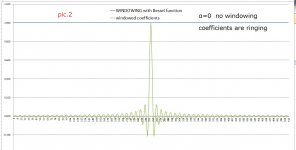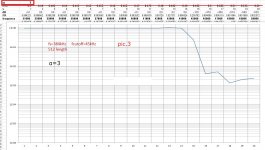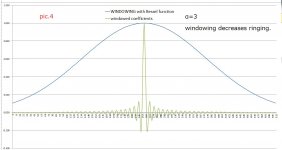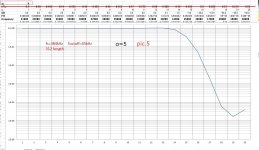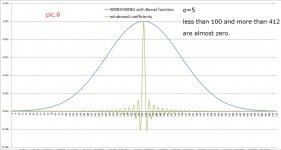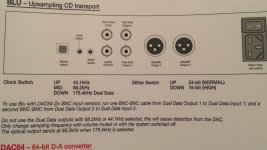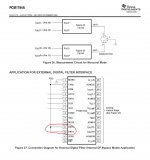The amp left and right channel phase response should be identical. Sometimes this factor can fall through the cracks. Not to mention the differences in tweeter specifications. Even the interconnects can influence the overall phase response - if one cable was not terminated properly: the way the shield is terminated to pin 1 (X 4 XLR connectors). All are very important with what you are doing (which I applaud!).
Indeed, I had to debug a lot in my full balanced system over the years, but now I feel it passes the phase tests. In fact, I spent the last evenings listening to phase check test tones😛 I'll try to capture this in a graph.
Figure 16-2 of post #349 shows that all the mentioned windowed sinc filters have ripples in the stopband. I wonder if there aren't any matching ripples in the passband that are just too small to see on this scale. At least they are there with the rectangular window of figure 16-1, second plot on the right side.
Does anyone know the answer?
I usually use inverse DFT on the frequency response I would want to have. As you say, the coefficients calculated by IDFT can't have good frequency response(pic.1 and pic.2). You can improve FR with windowing by a modified zeroth-order Bessel function though I don't know the principle in detail.😕 Pic.3 and pic.4 are alpha=3; a bit improved. Pic.5 and pic.6 are practical performance(alpha=5). Transition is a trade-off, but enough sharpness.
Attachments
...NOS does it in a dynamic way that lets you know something is pulsating there... OS vs NOS looks like sound vs energy. I still like NOS!...So, to summarize, without the tweeters I can't hear any difference...With the tweeters on, I feel there is something but not at the very high frequencies. To me it looks like the harmonics of the mid band projecting to the lower treble. When I find some time I will take a measurement with mid band white noise.
Kostas,
That is a very interesting subjective result. So, no audible difference with the tweeters disconnected. However, with the tweeters connected, there is an audible difference, except that difference doesn't subjectively seem to be related to the high-frequency. In a way, this echoes what I hear from my NOS playback. A characteristic NOS subjective difference, which also appears to affect lower frequencies as well.
The lower the signal frequency, however, the higher it's image frequency. So, one wouldn't expect lower frequencies to show any subjective affect via NOS playback. Yet, they seem to. Could this be related to the perception of recorded ambience or soundstage, do you suppose? Seems that, perhaps, the ultrasonic image-bands may be affecting our perception of the signal band should it not be properly 'reconstructed'. The possibility of which, I believe, is considered in item #3 on our suspect list.
Do you notice whether the disconnected tweeter mode seems to sound more like OS, just with some treble missing? Or more like NOS, just with some treble missing?
Last edited:
Ken, we seem to agree on this. Just to add that for me is more audible in the mids.Kostas,
That is a very interesting subjective result. So, no audible difference with the tweeters disconnected. However, with the tweeters connected, there is an audible difference, except that difference doesn't subjectively seem to be related to the high-frequency. In a way, this echoes what I hear from my NOS playback. A characteristic NOS subjective difference, which also appears to affect lower frequencies as well.
The lower the signal frequency, however, the higher it's image frequency. So, one wouldn't expect lower frequencies to show any subjective affect via NOS playback. Yet, they seem to. Could this be related to the perception of recorded ambience or soundstage, do you suppose? Seems that, perhaps, the ultrasonic image-bands may be affecting our perception of the signal band should it not be properly 'reconstructed'. The possibility of which, I believe, is considered in item #3 on our suspect list.
I'm unable to explain this due to the lack of theory backround... I can only make simple thoughts, more "analog" if I may say. So, what if we convert to digital and then to analog again a monotone square wave? Would harmonics look like this? Squarewave Testing (Fig 1-B) Or more images would be created? What does the sampling theory predict about that? I mean I'm trying to think the unreconstructed signal as multi square wave, but of course this may be completely meaningless...
I feel like listening a few days more before I could answer this. I'll report back.Do you notice whether the disconnected tweeter mode seems to sound more like OS, just with some treble missing? Or more like NOS, just with some treble missing?
To elaborate on my idiosyncratic theory, let's suppose a multitone sine wave consisting of 1kHz and 7kHz. In oversampling mode these are practically both sines and the 1kHz will modulate the 7kHz producing an expected harmonic pattern. But in NOS mode only the 1kHz is a sine modulating something at 7kHz that definitely is not a sine. The harmonics should be different, shouldn't they?
Yes, that is my thought...
I think that this is the biggest issue in audio... this i have tried to fix this in my system to the extreem... and it can be noticed by anyone who has 2 ears and is interested in audio that is...
I think that this is the biggest issue in audio... this i have tried to fix this in my system to the extreem... and it can be noticed by anyone who has 2 ears and is interested in audio that is...
Last edited:
Is there a threshold somewhere in the audio band where this kind of transition may happens in NOS or in OS? Or it should happen progressively across the band?
I guess so... but as you know i do use a FIR in my system (on my NOS dac), so it is not NOS after all. The issue is that it depends on the amount of filter taps (as far as i know now) on how good it performs. All other FIR's i tried did not even come close ! So then NOS is the way to go.
Attachments
I don't know... I'm using PCM1794 which is said not to manage real NOS because it does some kind of upsampling, but in my measurements it shows typically NOS. However, I can't take an impulse response.
Why not? This should be easy.
wavfile: A Simple Sound Library
Page 2 | Pulse Sound Effects | Soundsnap
https://www.nayuki.io/page/band-limited-square-waves
wavfile: A Simple Sound Library
Page 2 | Pulse Sound Effects | Soundsnap
https://www.nayuki.io/page/band-limited-square-waves
Last edited:
😱I should put a disclaimer in my signature about my total ignorance in writing code. But I admit it seems simple to give it a try. I'm wondering if there is a ready to use file waiting somewhere for poor diyers like me...
EDIT: I missed your edit. Thanks!
EDIT: I missed your edit. Thanks!
Last edited:
I created a test CD with some impulse and square wave signals. Such signals can't be produced by ADC. Perhaps it is useful. Write out to audio CD or feed to the DAC directly.
Test CD - Google Drive
Test CD - Google Drive
I don't know... I'm using PCM1794 which is said not to manage real NOS because it does some kind of upsampling, but in my measurements it shows typically NOS. However, I can't take an impulse response.
PCM1794 can process real NOS; it can do this if pins 11 and 12 are tied to Vcc. Then, it processes whatever comes via I2S. So, if you feed it a "raw" file (for example, a non-oversampled WAV file that was created by ripping the CD track, and played by JRiver with its DSP disabled), it will be working in true NOS. PCM1794 is not a true R-2R DAC, but it can work in true NOS mode, where its internal digital filter is bypassed.
EDIT: forgot to attach the screen capture.
Attachments
Last edited:
Thanks! I downloaded it. I got a message for corrupted files but seems usable. I'll try it!I created a test CD with some impulse and square wave signals. Such signals can't be produced by ADC. Perhaps it is useful. Write out to audio CD or feed to the DAC directly.
Test CD - Google Drive
Yes, this is how I've configured mine, using Doede's schematics as already said, and I confirm it works this way!PCM1794 can process real NOS; it can do this if pins 11 and 12 are tied to Vcc. Then, it processes whatever comes via I2S. So, if you feed it a "raw" file (for example, a non-oversampled WAV file that was created by ripping the CD track, and played by JRiver with its DSP disabled), it will be working in true NOS. PCM1794 is not a true R-2R DAC, but it can work in true NOS mode, where its internal digital filter is bypassed.
EDIT: forgot to attach the screen capture.
We Need Your Input
I invite everyone having a DAC featuring a purely analog, high-order output (reconstruction) filter to please share your subjective assessment of it's sound with the thread. Especially, regarding, in what ways it sounds different to you than OS digital filter based DACs you have spent time with. Your assessment must be of a DAC without any OS digital interpolation-filter in operation. Essentially, NOS with an entirely analog, high-order output filter. Similar to Sony's original CD-player architecture. This is input which those of you who have built Abraxalito's ling/phiDAC can provide valuable input toward the direction of the investigation.
For starters, I've included a couple of posts (links below) by Abraxalito, with brief comments addressing this question. While you will read that he slightly preferred 2xOS (via the Foobar 'SoX' upsampling utility), I would still like for us to obtain as wide a range of assessments regarding this as we can. Your input will help to clarify whether or not we yet can safely move on to a fully focused investigation of the subjective sound character produced by OS digital filter design/implementations.
1. https://www.diyaudio.com/forums/dig...-rbcd-multibit-dac-design-77.html#post6156871
2. https://www.diyaudio.com/forums/digital-line-level/371931-makes-nos-sound-4.html#post6645400
I invite everyone having a DAC featuring a purely analog, high-order output (reconstruction) filter to please share your subjective assessment of it's sound with the thread. Especially, regarding, in what ways it sounds different to you than OS digital filter based DACs you have spent time with. Your assessment must be of a DAC without any OS digital interpolation-filter in operation. Essentially, NOS with an entirely analog, high-order output filter. Similar to Sony's original CD-player architecture. This is input which those of you who have built Abraxalito's ling/phiDAC can provide valuable input toward the direction of the investigation.
For starters, I've included a couple of posts (links below) by Abraxalito, with brief comments addressing this question. While you will read that he slightly preferred 2xOS (via the Foobar 'SoX' upsampling utility), I would still like for us to obtain as wide a range of assessments regarding this as we can. Your input will help to clarify whether or not we yet can safely move on to a fully focused investigation of the subjective sound character produced by OS digital filter design/implementations.
1. https://www.diyaudio.com/forums/dig...-rbcd-multibit-dac-design-77.html#post6156871
2. https://www.diyaudio.com/forums/digital-line-level/371931-makes-nos-sound-4.html#post6645400
Last edited:
- Home
- Source & Line
- Digital Line Level
- What do you think makes NOS sound different?
